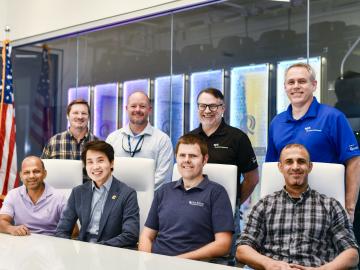
Filter News
Area of Research
News Topics
- (-) Molten Salt (10)
- (-) Quantum Computing (53)
- (-) Quantum Science (92)
- 3-D Printing/Advanced Manufacturing (146)
- Advanced Reactors (40)
- Artificial Intelligence (131)
- Big Data (79)
- Bioenergy (112)
- Biology (128)
- Biomedical (73)
- Biotechnology (39)
- Buildings (74)
- Chemical Sciences (86)
- Clean Water (33)
- Composites (35)
- Computer Science (226)
- Coronavirus (48)
- Critical Materials (29)
- Cybersecurity (35)
- Education (5)
- Element Discovery (1)
- Emergency (4)
- Energy Storage (114)
- Environment (218)
- Exascale Computing (67)
- Fossil Energy (8)
- Frontier (64)
- Fusion (66)
- Grid (74)
- High-Performance Computing (130)
- Hydropower (12)
- Irradiation (3)
- Isotopes (62)
- ITER (9)
- Machine Learning (68)
- Materials (157)
- Materials Science (158)
- Mathematics (12)
- Mercury (12)
- Microelectronics (4)
- Microscopy (56)
- Nanotechnology (64)
- National Security (86)
- Neutron Science (171)
- Nuclear Energy (122)
- Partnerships (68)
- Physics (69)
- Polymers (35)
- Security (31)
- Simulation (65)
- Software (1)
- Space Exploration (26)
- Statistics (4)
- Summit (71)
- Transportation (103)
Media Contacts

Huan Zhao, a Eugene P. Wiger Fellow at ORNL, focuses on advancing quantum materials and information technologies, inspired by his grandfather's passion for education. His research in energy-efficient memory devices and sensitive quantum light sources reflects his commitment to scientific progress and education equity.

Two papers led by researchers from ORNL received “Editor’s Choice” awards from the journal Future Generation Computer Systems. Both papers explored the possibilities of integrating quantum computing with high performance computing.

Researchers led by the University of Melbourne, Australia, have been nominated for the Association for Computing Machinery’s 2024 Gordon Bell Prize in supercomputing for conducting a quantum molecular dynamics simulation 1,000 times greater in size and speed than any previous simulation of its kind.
Researchers from ORNL have taken a major step forward in using quantum mechanics to enhance sensing devices, a new advancement that could be used in a wide range of areas, including materials characterization, improved imaging and biological and medical applications.

A new technology to continuously place individual atoms exactly where they are needed could lead to new materials for devices that address critical needs for the field of quantum computing and communication that cannot be produced by conventional means.

The Oak Ridge Leadership Computing Facility welcomed users to an interactive meeting at the Department of Energy’s Oak Ridge National Laboratory from Sept. 10–11 for an opportunity to share achievements from the OLCF’s user programs and highlight requirements for the future.

For the first time, ORNL will run equipment developed at its research facilities on a commercially available quantum network at EPB Quantum Network powered by Qubitekk to help validate the technology's commercial viability.

Researchers for the first time documented the specific chemistry dynamics and structure of high-temperature liquid uranium trichloride salt, a potential nuclear fuel source for next-generation reactors.

A study by more than a dozen scientists at the Department of Energy’s Oak Ridge National Laboratory examines potential strategies to integrate quantum computing with the world’s most powerful supercomputing systems in the pursuit of science.

The Quantum Computing User Forum welcomed attendees for a dynamic event at ORNL. The annual user meeting brought the cohort together to highlight results and discuss common practices in the development of applications and software for quantum computing systems.


